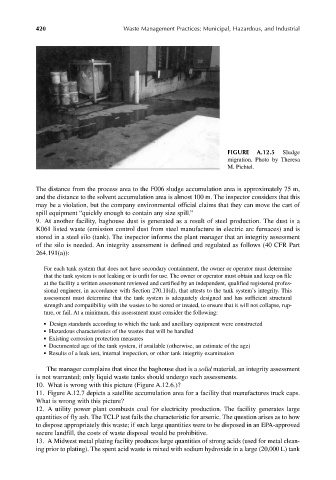Page 449 - Materials Chemistry, Second Edition
P. 449
CAT3525_C12.qxd 1/27/2005 4:11 PM Page 420
420 Waste Management Practices: Municipal, Hazardous, and Industrial
FIGURE A.12.5 Sludge
migration. Photo by Theresa
M. Pichtel.
The distance from the process area to the F006 sludge accumulation area is approximately 75 m,
and the distance to the solvent accumulation area is almost 100 m. The inspector considers that this
may be a violation, but the company environmental official claims that they can move the cart of
spill equipment “quickly enough to contain any size spill.”
9. At another facility, baghouse dust is generated as a result of steel production. The dust is a
K061 listed waste (emission control dust from steel manufacture in electric arc furnaces) and is
stored in a steel silo (tank). The inspector informs the plant manager that an integrity assessment
of the silo is needed. An integrity assessment is defined and regulated as follows (40 CFR Part
264.191(a)):
For each tank system that does not have secondary containment, the owner or operator must determine
that the tank system is not leaking or is unfit for use. The owner or operator must obtain and keep on file
at the facility a written assessment reviewed and certified by an independent, qualified registered profes-
sional engineer, in accordance with Section 270.11(d), that attests to the tank system’s integrity. This
assessment must determine that the tank system is adequately designed and has sufficient structural
strength and compatibility with the wastes to be stored or treated, to ensure that it will not collapse, rup-
ture, or fail. At a minimum, this assessment must consider the following:
● Design standards according to which the tank and ancillary equipment were constructed
● Hazardous characteristics of the wastes that will be handled
● Existing corrosion protection measures
● Documented age of the tank system, if available (otherwise, an estimate of the age)
● Results of a leak test, internal inspection, or other tank integrity examination
The manager complains that since the baghouse dust is a solid material, an integrity assessment
is not warranted; only liquid waste tanks should undergo such assessments.
10. What is wrong with this picture (Figure A.12.6.)?
11. Figure A.12.7 depicts a satellite accumulation area for a facility that manufactures truck caps.
What is wrong with this picture?
12. A utility power plant combusts coal for electricity production. The facility generates large
quantities of fly ash. The TCLP test fails the characteristic for arsenic. The question arises as to how
to dispose appropriately this waste; if such large quantities were to be disposed in an EPA-approved
secure landfill, the costs of waste disposal would be prohibitive.
13. A Midwest metal plating facility produces large quantities of strong acids (used for metal clean-
ing prior to plating). The spent acid waste is mixed with sodium hydroxide in a large (20,000 L) tank

